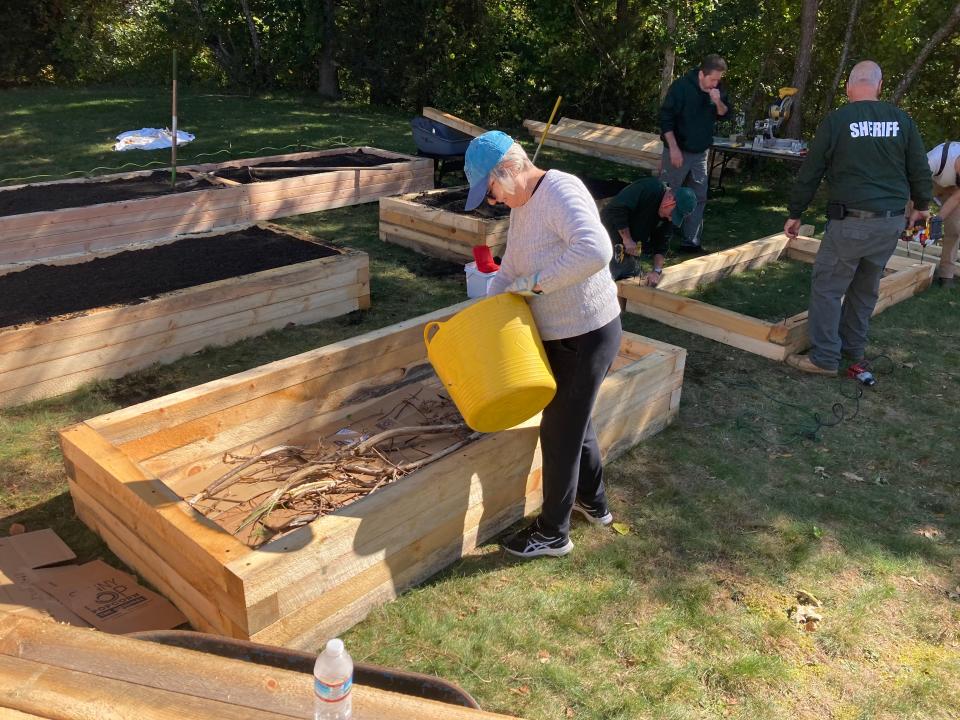Raised-bed gardening offers a different approach for backyard vegetable growers
Raised-bed gardening has become a popular practice. Smaller lots and families have led to the downsizing of planting areas and the amount of produce needed.
Raised-bed gardening is fun and enjoyable for the gardening enthusiast. Planting and tending a garden is still a favorite for millions of Americans and the taste of fresh-picked vegetables is beyond compare.
This spring, I would encourage you to think about growing vegetables in a raised bed.
Raised-bed gardens offer several advantages over conventional gardening plots. Soil raised above ground level warms up quicker in the spring, which allows for earlier planting dates. These beds are usually filled with high-quality soil, which improves drainage and increases yield. Raised beds are smaller than traditional gardens, making them easier for most people to maintain. For example, the denser plantings help reduce weed infestations.
The main disadvantage of this system is that elevated beds tend to dry out more quickly in the summer months, increasing the need for watering. The beds are usually raised off the ground six to eight inches but many are designed taller to limit gardeners having to bend over.

The framework for this structure can be made from several types of materials. Most gardeners use some sort of framing materials such as railroad ties, landscape timbers, planking, rock, manufactured blocks or bricks. Wood products should be treated with preservative to increase the life of the structure because rot can become a problem.
Questions sometimes arise over the use of treated lumber in vegetable beds. The most common wood preservative traditionally used (chromated copper arsenate or CCA) was phased out on in 2003 for virtually all residential use, including raised beds. Two other products, ACZA (ammoniacal copper zinc arsenate) and ACQ (ammoniacal copper quat) have replaced CCA and may be used for raised bed construction.
Well-documented research has shown that CCA, ACZA and ACQ may be safely used to construct vegetable beds. However, some gardeners still prefer to line the sides of beds with polyethylene plastic so that roots do not come into contact with the material. Do not use plastic on the bottom of the beds as this will prevent drainage and cause long term problems.
The size of the raised bed varies depending on the gardener. A suggested size is either four feet by eight feet or four feet by 10 feet. The four-foot width is preferred because it allows for an easy reach into the bed from either side to tend the plants. This keeps soil compaction from occurring because the garden soil is not walked on. Length of the bed can also vary depending on type of construction materials used and the space available for the bed.
A six- to eight-inch depth is recommended because this will allow the added drainage and improve soil tilth needed to produce healthy plants. This depth is also where most of the main feeder roots of the vegetable crops will be located for nutrients and water uptake.
As with any garden site, the bed should be located in full sun for best production. If a full-sun location is not available, pick a spot that will get at least a half day of sunlight – shady areas will result in poor production.
The bed should also be located with a water source in close proximity, as raised beds will require more water than conventional plantings. The best location also provides wind protection. A tree, shrub screen or border will work if it is on the south or southwest side to protect the garden from harsh summer winds.
One of the greatest advantages to raised bed gardening is the ability to amend the soil. For instance, soils in some areas tend to have high clay content, which drain poorly and are hard to till when either too wet or dry. Soils in newly constructed areas are not always adequate. Raised beds are wonderful in this situation. Several types of amended soil mixes can be used, but usually include good topsoil and organic matter often in similar portions. This gives you a planting mix that drains well and is easy to till.
When incorporating the soil mix, several guidelines should be followed. It is best to loosen or spade the existing soil. This will improve drainage from the bed and prevent waterlogging. Spade or till six to eightinches deep. Next, blend a small amount of the amended soil mix into the existing soil.
This will help avoid the problems that can arise from having two different soil layers. Incorporate about two inches of mix into the upper few inches of existing soil. You are then ready to begin filling the raised bed. The result will be 10 to 12 inches of rich soil for plants to grow in.
Fertilization needs of a raised bed garden are the same as a traditional garden. It is best to start with a soil test. Before planting in the spring, a general application of about one pound of 10-10-10 can be spread over 100 square feet of bed and incorporated. Side-dress the crops during the growing season based on needs of individual crops. Do not over fertilize, as this will lead to poor production.
As with any gardening product, the fun and rewards come from your own experimentation and finding the techniques that work best for you.
P. Andrew Rideout is the UK Extension Agent for Horticulture and can be reached at pandrewrideout@uky.edu.
This article originally appeared on Evansville Courier & Press: What is a raised-bed garden?

